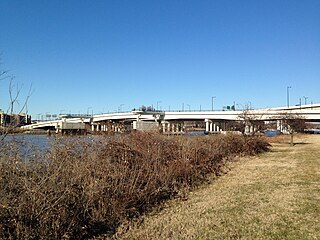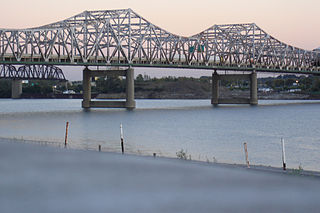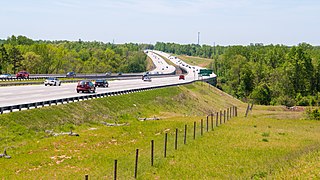
The Clay's Ferry Bridge is a bridge that carries Interstate 75 along with US 25 and US 421 across the Kentucky River between Madison and Fayette counties. [1]

The Clay's Ferry Bridge is a bridge that carries Interstate 75 along with US 25 and US 421 across the Kentucky River between Madison and Fayette counties. [1]

The first Clay's Ferry Bridge was opened in 1869. [3] Prior to this, service across the Kentucky River was provided by ferry, [4] which had been established since 1792. [3]
In 1906, the bridge was purchased by the newly formed Clays Ferry Bridge Company. [3]
After the State of Kentucky purchased the crossing on April 1, 1929, the bridge was made part of US 25. [3] Despite this, the bridges tolls were not removed until December 24, 1930. [3]
On February 6, 1941, plans for a new high rise span were announced. It was estimated to cost around $935,279. Approval for the construction of the new Clay's Ferry Bridge was granted by the Secretary of War on September 12, and work on this new span began on October 1. Even though World War II-related steel rationing delayed completion of the superstructure, the piers were completed on January 7, 1943. Steel was eventually obtained. After multiple delays related to winter weather, the bridge was officially opened to traffic on August 17, 1946. [3] It was 280 feet (85 m) above the river level and was the tallest bridge east of the Mississippi after completion, [5] with a total length of 1,736 feet (529 m). [4]
In 1951, us route 421 was routed over the high rise bridge. [3]
In 1955, the low rise bridge was given a rehabilitation. [6]
In 1963, a twin high rise bridge was completed just south of the existing bridge and traffic ran in two lanes in each direction, With the completion of this new span, the original span was made northbound only. [7]
After over two decades of use, a fatigue analysis of the Clays Ferry Bridge was completed. This was conducted in 1988 by Theodore Hopwood II, and Vishwas G. Oka, from the Kentucky Transportation Center Research, Report 539. In 1989, plans were announced to demolish the 1946 and 1963 bridge's superstructures and build a third pier. At this point, a new unified superstructure would be constructed across all three. This allowed for the addition of an extra vehicular lane plus shoulders. Construction started on January 6, 1994. On February 29, 1996, a crane leaned forward at a 30-degree angle while attempting to lift a 17-ton steel beam, nearly collapsing the bridge. Fearing the crane might fall into the river, engineers closed the bridge until 11:15 p.m. In this span of time, a new crane was brought in to carry the steel beam, in addition to stabilizing the crane. The operator chose to drop the beam onto the river bank, preventing it from falling off. This beam was the only item damaged during the incident. In the summer of 1998, crews finished painting, and by November, the entire project was completed. [3] Each northbound/southbound roadway is 60 feet (18 m) wide, and total traffic over the bridge was 75,000 vehicles per day in 2015. [8] [9]
A resurfacing of the bridge began on August 1, 2021, and was projected to be completed by October 27. It was completed ahead of schedule on October 11. [10]


Navajo Bridge is the name of twin steel spandrel arch bridges that cross the Colorado River in the Grand Canyon National Park in northern Coconino County, Arizona, United States. The newer of the two spans carries vehicular traffic on U.S. Route 89A (US 89A) over Marble Canyon between Bitter Springs and Jacob Lake, allowing travel into a remote Arizona Strip region north of the Colorado River including the North Rim of Grand Canyon National Park.

The Carquinez Bridge is a pair of parallel bridges spanning the Carquinez Strait at the northeastern end of San Francisco Bay. They form the part of Interstate 80 between Crockett and Vallejo, California, United States.

The 11th Street Bridges are a complex of three bridges across the Anacostia River in Washington, D.C., United States. The bridges convey Interstate 695 across the Anacostia to its southern terminus at Interstate 295 and DC 295. The bridges also connect the neighborhood of Anacostia with the rest of the city of Washington.

The Sherman Minton Bridge is a double-deck through arch bridge spanning the Ohio River, carrying I-64 and US 150 over the river between Kentucky and Indiana. The bridge connects the west side of Louisville, Kentucky to downtown New Albany, Indiana.

The John F. Kennedy Memorial Bridge is a six-lane, single-deck cantilever bridge that carries southbound Interstate 65 across the Ohio River, connecting Louisville, Kentucky and Jeffersonville, Indiana. The main span is 700 feet (213 m) and the bridge has a total length of 2,498 feet (761 m). The span carries six southbound lanes. It is named after U.S. President John F. Kennedy.

The Milton–Madison Bridge is a continuous truss bridge that connects Milton, Kentucky and Madison, Indiana. It carries approximately 10,000 cars a day.

The Hale Boggs Memorial Bridge is a cable-stayed bridge over the Mississippi River in St. Charles Parish, Louisiana. It is named for the late United States Congressman Hale Boggs.

The Ohio River Bridges Project (ORBP) was a 2002–2016 transportation project in the Louisville metropolitan area primarily involving the construction of two Interstate highway bridges across the Ohio River and the reconstruction of the Kennedy Interchange near downtown Louisville.

The Ironton–Russell Bridge can refer to either one of two bridges that carry/carried traffic along the Ohio River between Ironton, Ohio and Russell, Kentucky in the United States. The original blue cantilever Ironton–Russell Bridge, opened in 1922 and closed in 2016, carried two lanes of traffic and a narrow sidewalk. The new white cable-stayed bridge, officially named the Oakley C. Collins Memorial Bridge, has two lanes of traffic without a dedicated sidewalk and opened on November 23, 2016.

The Liberty Bend Bridge is the common name for the two continuous truss bridges on Route 291 over the Missouri River in Sugar Creek, Missouri in the Kansas City metropolitan area. Although the bridges cross over the Missouri River, they do not cross the county line. When the Missouri River was rerouted in 1949, it cut across the northern part of Jackson County, Missouri. This left part of the county north of the river, which is known as River Bend. The original Liberty Bend Bridge was located about two miles to the north, which then crossed over into Clay County, Missouri.

The Bi-State Vietnam Gold Star Twin Bridges,, are located in Henderson County, Kentucky and connect Henderson, Kentucky, and Evansville, Indiana, along U.S. Route 41 (US 41), two miles (3.2 km) south of the current southern terminus of Interstate 69 (I-69). The two bridges average more than 40,000 vehicles crossings a day across the Ohio River.

The Pearl Harbor Memorial Bridge, commonly referred to as the Q Bridge by locals, is an extradosed bridge that carries Interstate 95 over the mouth of the Quinnipiac River in New Haven, in the U.S. state of Connecticut. This bridge replaced the original 1,300 m (0.8 mi) span which opened on January 2, 1958. The old bridge had a girder and floorbeam design where steel beams supported a concrete bridge deck that carried three lanes of traffic in each direction with no inside or outside shoulders. The bridge was officially dedicated as the Pearl Harbor Memorial Bridge in 1995 to commemorate the attack on Pearl Harbor.

Interstate 75 (I-75) is a part of the Interstate Highway System that runs 1,786.47 miles (2,875.04 km) from Miami Lakes, Florida to the Canada–United States border at Sault Ste. Marie, Michigan. In the U.S. state of Kentucky, I-75 runs through the eastern half of the state, from the Tennessee state line near the city of Williamsburg to the Ohio state line near Covington. The Interstate serves the state's second-most populous city, Lexington. Outside of it, the route is mostly rural or suburban in nature, mainly providing access to other cities via state and U.S. Highways. The major landscapes traversed by I-75 include the rolling hills and mountains of the Cumberland Plateau, the flat Bluegrass region, the urban core of Lexington, and the highly urbanized suburbs of Northern Kentucky; it also very briefly crosses through the Eastern Kentucky Coalfield at its southernmost stretch and passes near the Daniel Boone National Forest in London.

Moses Wheeler Bridge carries Interstate 95 over the Housatonic River between Stratford and the Devon section of Milford. The current bridge is a 14-span continuous girder and floorbeam structure that carries three lanes of traffic in each direction, with full inside and outside shoulders. The current bridge, completed in 2016, replaces a pre-existing structure that was completed as part of the original Connecticut Turnpike in 1958. The original bridge was a 34-span plate girder structure with a concrete deck with three 12-foot travel lanes in each direction and no shoulders. The central span of the original bridge over the river's navigation channel included a pin and hanger assembly, which are no longer used in bridge construction in the United States. Construction on the Moses Wheeler Bridge began in 1955 and opened on January 2, 1958.

The Carl E. Stotz Memorial Little League Bridge, formerly known as the Market Street Bridge, carries approximately 27,700 vehicles a day on U.S. Route 15 over the West Branch Susquehanna River between Williamsport and South Williamsport in Lycoming County, Pennsylvania, in the United States. It is the seventh bridge on the site and was built at a cost of over $60,000,000.
The Yadkin River bridges are bridges crossing the Yadkin River between Rowan and Davidson Counties near Spencer, North Carolina in the United States. The northbound span of the Yadkin River Veterans Memorial Bridge, the first of two carrying Interstate 85 / U.S. Highway 52, opened May 5, 2012, and on August 2, 2012, southbound traffic moved to that span as well. A southbound span of the same bridge was completed in October 2012 and opened to traffic in March 2013. Each span carries four lanes of traffic.
The Mianus River Bridge is a span that carries Interstate 95 over the Mianus River, between Cos Cob and Riverside, Connecticut. It is the second bridge on the site. The original bridge collapsed in 1983, resulting in the deaths of three motorists. The replacement span is officially named the Michael L. Morano Bridge, after a state senator Michael L. Morano who represented Greenwich.

The San Mateo–Hayward Bridge is a bridge crossing the American state of California's San Francisco Bay, linking the San Francisco Peninsula with the East Bay. The bridge's western end is in Foster City, a suburb on the eastern edge of San Mateo. The eastern end of the bridge is in Hayward. It is the longest fixed-link bridge in California and the 25th longest in the world. The bridge is owned by the state of California, and is maintained by California Department of Transportation (Caltrans), the state highway agency. Further oversight is provided by the Bay Area Toll Authority (BATA).

Auchenshuggle Bridge is a road bridge spanning the River Clyde in Glasgow, Scotland. The Auchenshuggle Bridge is the latest road bridge to be built over the Clyde in the Auchenshuggle district of Glasgow, carrying the M74 motorway over the river and onto land which is part of Clydebridge Steelworks in Rutherglen, en route to the M8 junction near the heavily congested Kingston Bridge.

The Yadkin River Veterans Memorial Bridge is a pair of bridges, each carrying four lanes of I-85/US 52 across the Yadkin River between Rowan and Davidson Counties near Spencer, North Carolina in the United States. The northbound span opened May 5, 2012, and on August 2, 2012, southbound traffic moved to that span as well. A southbound span of the same bridge was completed in October 2012 and opened to traffic in March 2013. The pair of bridges replaces twin spans that carried I-85/US 52 from 1957 to 2012, which were separated by less than 1,000 feet (300 m). Adjacent are two Warren deck trusses carrying the North Carolina Railroad and Norfolk Southern, one bridge carrying US 29/US 70/NC 150, and the historic concrete arch Wil-Cox Bridge.